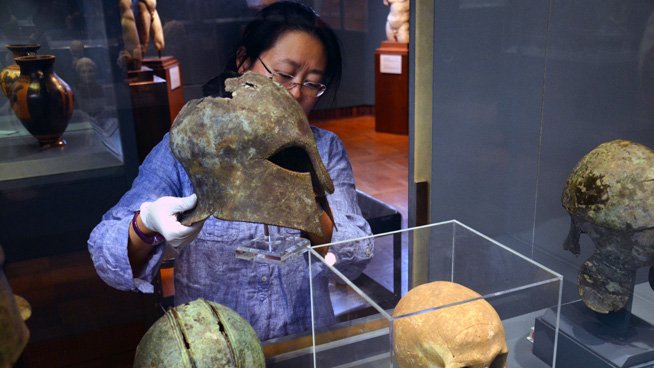In the realm of ancient history, the Corinthian helmet stands as an unmistakable symbol, closely associated with the great heroes of Ancient Greece. Although the Greeks themselves quickly moved to helmets with better visibility, they continued to depict their heroes wearing the iconic Corinthian helmet. Modern portrayals of Ancient Greek warriors often feature this type of helmet, albeit sometimes modified to suit cinematic aesthetics, such as exposing more of the actor’s face.
The Helmet’s Provenance

This particular Corinthian helmet (ROM no.926.19.3) was acquired by the Royal Ontario Museum (ROM) in 1926 from T. Sutton of 2 Albemarle St., London, England, via a Sotheby’s auction held on July 22, 1926 (lot 160). At one point, a skull (ROM No. 926.19.5) was said to have been found inside the helmet. This artifact was reportedly excavated by George Nugent-Grenville, 2nd Baron Nugent of Carlanstown, on the Plain of Marathon in 1834, according to letters from Sutton dated August 2 and 20, 1826.
Also included in this lot, which sold for 80 pounds, was a “Spartan type” helmet found by Nugent at Thermopylae in 1834 (ROM no. 926.19.4). Nugent (1788-1850) served as the High Commissioner of the Ionian Islands from 1832-1835 but died without issue. The Sutton letters state that the finds “came by descent in the family into the possession of the Boileau family, and remained with them until they were sold to me (Sutton) by Lt. Col. R.F. Boileau of Ketteringham Park, Norfolk.”
Historical Significance

The Battle of Marathon in 490 BC is considered one of the most pivotal battles in history. It was during this battle that the Greeks defeated the invading Persians, thereby paving the way for the development of Greek Classical civilization. Thermopylae, a narrow pass, was the site of several battles, but Nugent was likely most interested in the 480 BC battle where 300 Spartans (along with other Greek forces) famously held the pass against the Persians.
While the attribution of these helmets to these battles is not entirely certain, it is conceivable that a British antiquarian like Nugent, digging around these historically significant sites shortly after Greece gained independence (1821-1832), could indeed find such artifacts.
The Skull Controversy

The association between the helmet and the skull is more ambiguous. Since Marathon was a Greek victory, the Greeks would have likely reclaimed any useful equipment and body parts from the battlefield. The helmet shows no damage other than that caused by age, suggesting it might not have been lost in battle. However, finding a helmet with a skull inside is not unheard of on battlefields, although it is typically not the case with the victors.
Nugent’s discovery in 1834 seems credible, and while he was a romantic, there is nothing in his biography to suggest he was prone to fabricating tales. However, a century passed between the discovery and our records, making the reliability of information transmission questionable. Without DNA and radiocarbon studies, which are not currently planned, we cannot be certain if the skull belonged to the helmet’s owner.
Examination and Analysis
Recently, the Nugent Marathon helmet was examined to gather information for Matt Lukes, who creates equipment for reenactors and wanted to replicate the Corinthian helmet. Lukes hoped the helmet had been raised from a sheet of bronze and aimed to replicate this process using modern techniques.
In the examination, the helmet was found to weigh 1193.1 grams, with only a part of the very thin crown missing—suggesting this is close to the original weight. For comparison, a WWII American M1 helmet weighs about 1300 grams, and the British Mark II is 1050 grams. The helmet’s face is relatively thick, with the nasal area up to 10 mm, and other parts of the face measure between 2 mm and 3 mm. The back and crown are very thin, under 1 mm thick, with the edge of the helmet thicker and rapidly thinning. This design would provide effective protection for the face in hoplite warfare, characterized by spear thrusts over or around large round shields.
The analysis suggests that the helmet’s face and general form were cast, with the final bowl shaped by hammering into its final form.
The Corinthian helmet from the Battle of Marathon remains an intriguing artifact, symbolizing the heroism of Ancient Greek warriors. While the exact history and association with the skull remain uncertain, the helmet itself provides valuable insights into the craftsmanship and battlefield strategies of the time. As we continue to study such artifacts, they offer a tangible connection to.
